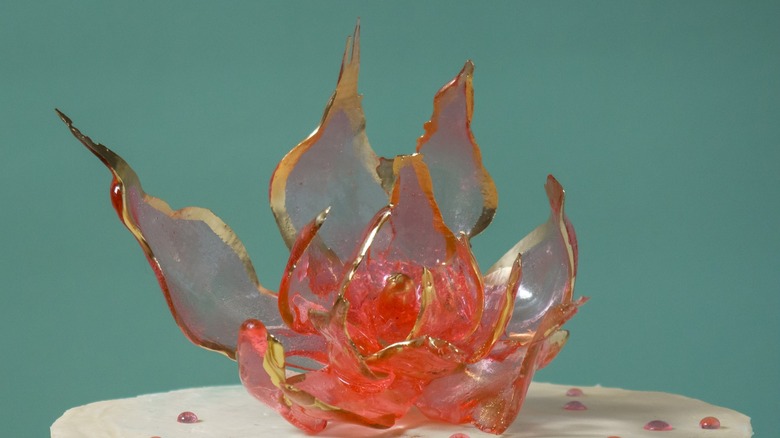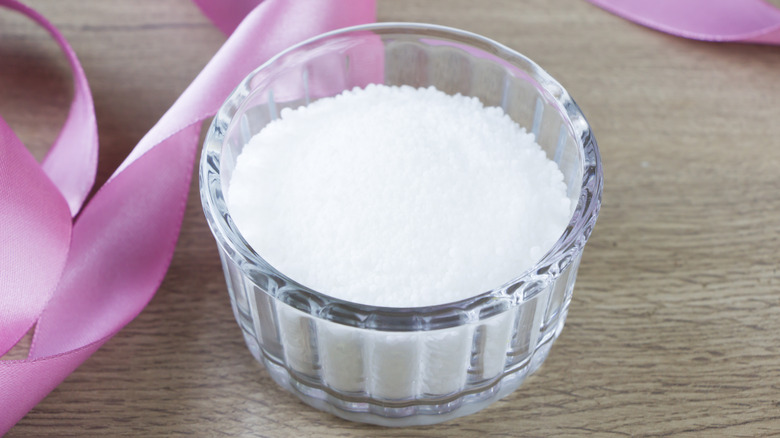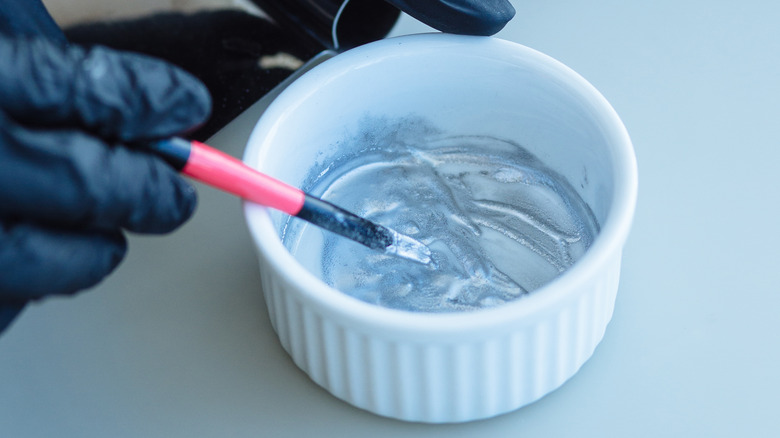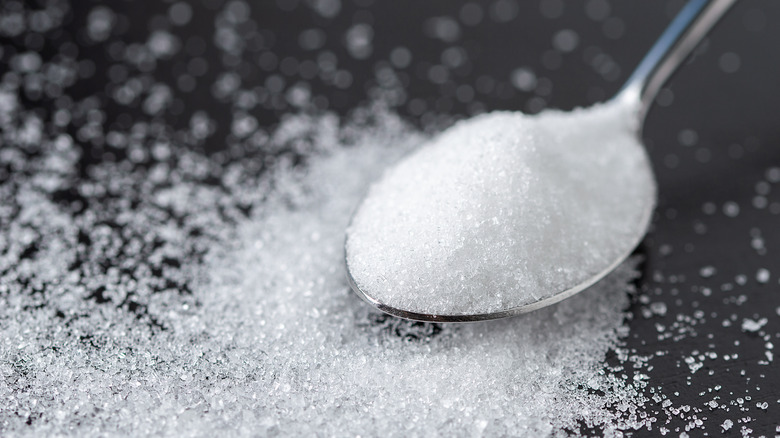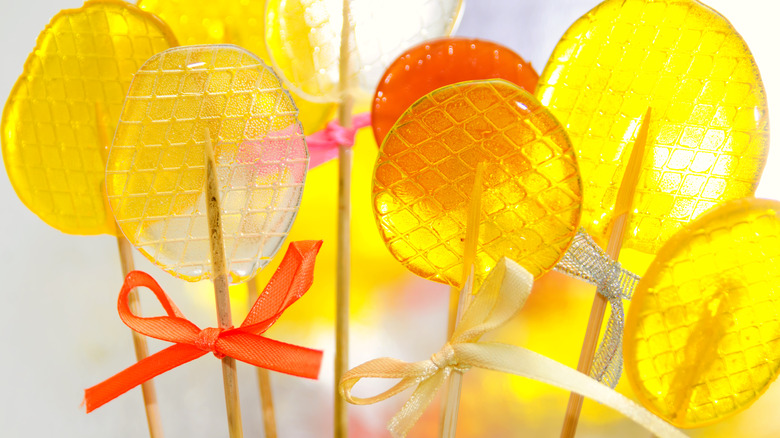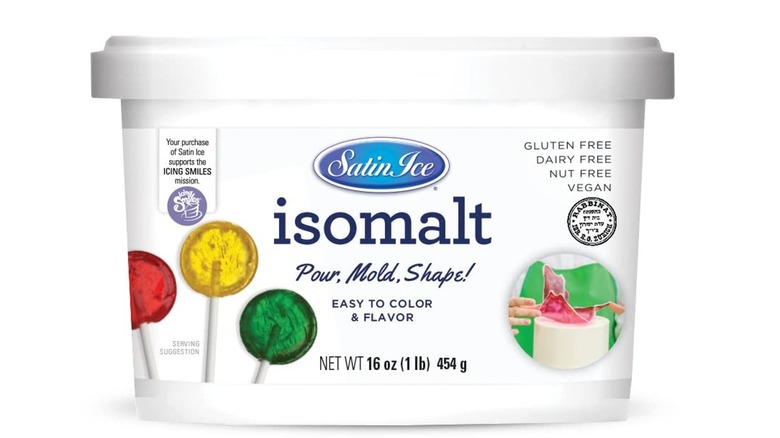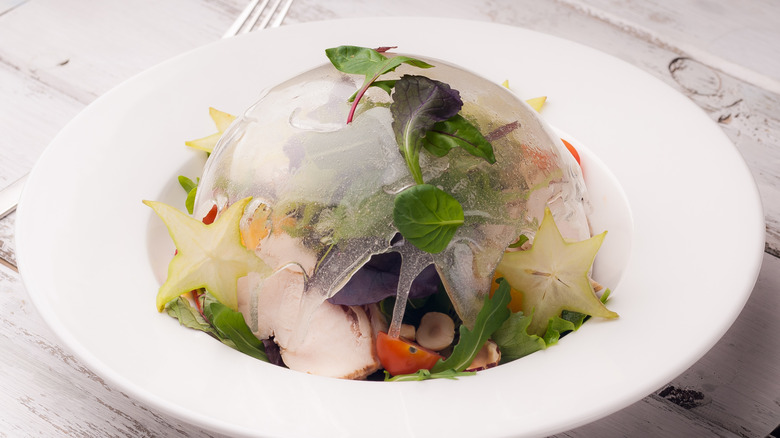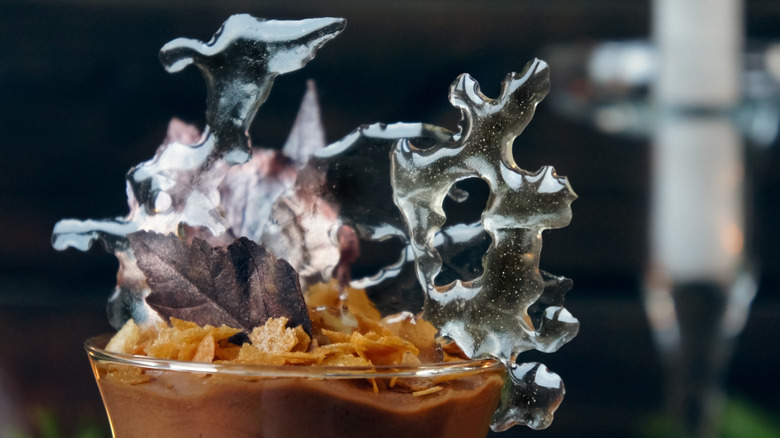What, Exactly, Is Isomalt Sugar?
If you've tuned into any of the myriad Food Network baking competition shows, you've undoubtedly seen competitors using isomalt to make their projects spectacular. Chefs heat a bowl of white grains and suddenly they have magical, molten, edible glass for making decorative gem-like candy, window panes, and all sorts of crystalline accents that take their baked goods into the realm of culinary art. It's even used as an adhesive for building gingerbread houses when royal icing isn't strong enough to get the job done.
But isomalt is more than just a baking challenge show-stopper, and even if you haven't heard the name before, you've undoubtedly encountered it somewhere in your daily life. As an alternative to table sugar, isomalt is frequently used in hard candies, sugar-free cough drops, and chewing gum. With the incredible amount of sugar Americans eat every day, incorporating a versatile sweetener like isomalt into an industry where sugar rules is a no-brainer.
So what is isomalt, exactly? And how can you work it into your kitchen activities? We set out on a search to learn the facts about this intriguing ingredient to give you the inside story. If you're looking to step up your cake-baking game, or you're simply eager to know how isomalt came to be and how it factors into the food world, our granular explanation will be a sweet revelation.
What is isomalt?
Isomalt may seem like a recent innovation, but it was actually developed in Germany in 1957 as a patented chemical called isomaltulose and was introduced as a food-safe non-sugar sweetener in the U.S. in 1990. It's used in over 70 countries around the globe to meet the needs of modern eaters in search of lower-calorie sweets. With sugar appearing in so many foods, isomalt provides a solution that helps those with a die-hard sweet tooth make more mindful choices. It's an FDA-approved product, falling under the Code of Federal Regulations Title 21 along with other artificial sweeteners in the category of GRAS, or generally recognized as safe.
Isomalt can be found in industrial-level quantities under names like IsoMaltidex, a version sold by international food company Cargill as a bulk sweetener for hard candies. One of isomalt's more desirable qualities for food producers is its resistance to sticking to itself when dried, preventing unwrapped hard candies from clumping together. This helps prolong the shelf life and salability of many products while reducing the need for disposable cellophane wrappers.
How is isomalt made?
Isomalt is chemically classified as a polyol, a family of sugar substitutes that also includes sorbitol and xylitol. You may have seen these sweeteners listed on packages of sweetened foods, though they can also be found in toothpastes and medicines. Unlike more familiar sweeteners like sucralose and saccharine that provide powerful sweetness at smaller quantities, isomalt is a one-to-one replacement for refined sugar by quantity, but with reduced sweetness and only half the calories.
This adaptable ingredient is produced through a chemical process that alters beet-derived sucrose (sugar) into isomaltulose by applying an enzyme called isomaltulose synthase. The isomaltulose is then hydrogenated, resulting in a substance comprised of two different sugar alcohols called gluco-sorbitol and gluco-mannitol. This is finished isomalt, which is crystalline in form just like sugar. The similarity of form makes isomalt as easy as granulated sugar to measure and work with. But unlike sugar, isomalt doesn't cause tooth decay, making it a prime sweetener for sugar-free gum and candy. It also doesn't caramelize or discolor when heated, something candy makers and confectioners who work with pulled sugar can appreciate.
Isomalt vs. sugar
Though isomalt may not be a type of sugar you've used in your baking, understanding how it compares to granulated sugar can help you recognize potential uses. Because isomalt is sold as crystals, you can scoop and measure isomalt crystals as easily as sugar. Once isomalt is melted, it becomes transparent and hardens to a glass-like consistency, just like melted sugar.
Even with these similarities, there are notable differences that limit your uses for isomalt. Unlike other sugar substitutes like Truvia that are designed to replace sugar for general baking, isomalt isn't quite so friendly. According to the International Journal of Dentistry, it's a disaccharide sugar alcohol that can pass through the digestive tract while only partially digested, causing gastrointestinal distress similar to xylitol. For this reason, isomalt should only be consumed in small quantities. So despite its one-for-one measurement similarities to sugar and its easy-to-use granular form, it's definitely not an ingredient you should use in place of general-purpose sugars aside from limited applications, such as decorative candies and ornaments.
What does isomalt taste like?
Though isomalt perfectly emulates the texture and consistency of melted sugar, it imparts a taste that's much less sweet. Because some of your isomalt creations may be eaten, you can add oil-based flavorings like what you would add to regular sugar-based hard candies to give them a more palatable taste. This is especially helpful when using isomalt in lollipops and candy decorations to top cakes and cupcakes. Not only will your finished creations look more polished and artful, but the flavors of all the elements will relate to one another, provided you add complementary oils to your isomalt. Choosing a bit of mint for ornaments on a chocolate cake, for example, or cinnamon for a spice-based cake, will keep your flavors aligned rather than causing a catastrophic clash.
Overall, it's best to be conservative when flavoring and using isomalt in your kitchen. Eating isomalt décor that's too thick or over-flavored isn't necessarily a pleasurable experience; the taste shouldn't detract from your main item, but the hard texture of isomalt candy might make chewing a bit of a challenge. If used sparingly in homemade projects, it can be separated from the tastier edible elements when served.
How to cook with isomalt
Isomalt is a perfect substitute for melted sugar in baking, allowing you to create striking decorations for professional-level flair. Add food coloring to create jewel tones for stained glass or to replicate precious stones, or pour it into molds for whimsical candy shapes that bring wit and wonder to your dessert displays. Anything you add isomalt ornaments to will shine a new light on your baking abilities.
Adding a bit of water will prepare your isomalt crystals for cooking. Isomalt melts when heated to 338 degrees Fahrenheit and hardens in 10 minutes, making an easy-to-heat, quick-dry coating and adhesive that lets you work with minimal delay. It can even be melted in a microwave oven. Because bubbles can form, baking melted isomalt spread onto a Silpat-lined baking sheet in a 275-degree oven for 15 minutes is advised to clarify the substance before using. Chefs should be aware that isomalt is stable in dry and mildly humid conditions, but it becomes temperamental when humidity is present; moist environments tend to keep cooked, unhardened isomalt in its stickier form. This means dry-weather days and climate-controlled kitchens are best, especially when working for speed and adhesion.
Once you have the hang of preparing your isomalt, you can try piping isomalt into shapes, forming it over domes to create natural forms, or filling cut-away spaces in cookies for charming window-like effects. A little practice should yield a world of satisfying results.
Where to buy isomalt
Because isomalt has become a preferred ingredient among bakers looking to make a splash, just about anywhere you buy cake decorating supplies, you'll find isomalt, too. You can look for a wide variety of brands and quantities from Amazon if you prefer shopping online, though you can find it on shelves at brick-and-mortar craft stores like JoAnn and Michael's as well. Specialty cake decorating shops and websites may sell versions that are more suitable to your needs, especially as your skill with isomalt develops.
If you have a dedicated cake shop in your area, you can stop by and ask to see the isomalt selection. If isomalt isn't currently part of the stock, you might ask if it can be ordered for pick-up or added to the store's inventory, if you'll be using it on an ongoing basis. It's unlikely that you'll find isomalt at a regular grocery store.
Varieties of isomalt
Isomalt is available in a variety of forms, including grains, pellet-like nibs, and sticks. Grains are the form most frequently seen on cooking shows; they're also more affordable than the other forms, which makes them appealing for practice and repeated use. Nibs are about the size of rock candy crystals, while sticks look similar to what you'd use in a glue gun. Some sticks come pre-colored, making it easier to add hues to your isomalt décor.
As for quantity, because isomalt is used for the mass production of foods, it's available in industrial quantities from suppliers for inclusion in candies, gum, and oral hygiene products. Unless you own a candy factory, you won't need quite so much isomalt in your life. The best quantity for your purposes will be smaller packages used by confectioners and cake decorators. 16-ounce packages are a great place to start. If you find yourself using it more regularly, you can graduate up to 5-pound or even 10-pound packages.
How to store isomalt
As with granulated sugar, isomalt is subject to deterioration when it comes into contact with moisture. To get the most out of your isomalt, make sure it's stored in an airtight container for maximum freshness and usability. Your purchased product may include a packet of silica gel to make sure it stays dry; this packet should remain in the container for the life of the product. Whether cooked or in granular form, it should also remain at temperatures lower than room temperature, though it should not be stored in the refrigerator. If kept properly, you can depend on your isomalt to be usable for up to two years.
Because isomalt will most likely be an ingredient you pull out when making cakes and confections, you can keep a container stashed with your decorating kit or your baking ingredients. Having a bit of isomalt handy will allow you to let your imagination run wild when it comes time to make a showstopping creation for whatever special occasion comes next.
